Future Passed: When we dreamed of television
The rush to create television was started by a rumor.
In 1880 Alexander Graham Bell, the famed inventor of the telephone, sealed documents related to his latest invention and gave them to the Smithsonian Institution. When word got out that his mystery invention was called the “Photophone,” many people assumed that Bell had figured out how to mechanically send pictures from one point to another. Many had no doubt gotten the idea that such an invention was in the works after seeing illustrations of the the fictional “telephonoscope” in the December 9, 1878 issue of Punch magazine.
Word quickly spread and inventors rushed to guess at what futuristic technology would allow for sending pictures over a distance. People all over the world flooded the pages of magazines like Scientific American and English Mechanic, trying to guess in articles and letters to the editor just how Bell’s “Photophone” worked.
In fact, some people were angry that Bell was hiding his invention, speculating what a tremendous innovation could do for humankind. The London publication Brief: The Week’s News ran a short piece that didn’t even mention Bell by name, instead calling him the “inventor of the telephone” and protesting that Bell wouldn’t share his marvelous invention with the world.
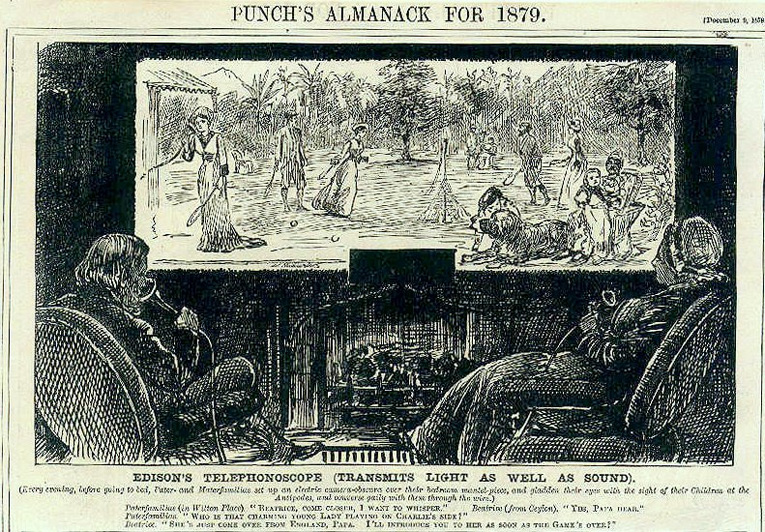
As it turns out, Bell’s Photophone wasn’t a way to “see by telegraph” as most speculated, but was actually a method of transmitting sound through a beam of light. Cool, no doubt; but no television.
We live in a time when it’s hard to define what television is precisely. Is television defined by the device you’re watching it on? Is television defined by the length of a certain piece of visual media? Am I using television if I chat with someone through a TV screen over the internet? The thing is, it’s always been that way. The history of the future of television is particularly messy because no one at any given time has been happy with defining exactly what it is.
Another part of the confusion over television’s history stems from the fact that there isn’t a single Founding Father of Television. Of course, most groundbreaking technologies lack a sole inventor — as is evidenced by the geeks who like to point out all the ways in which Thomas Edison screwed over Nicola Tesla. Or the multitidue of names that contributed to what we now call the internet. Television though, had such a long, hard fight to determine first what it was technologically, that it delayed many in thinking about its full potential.
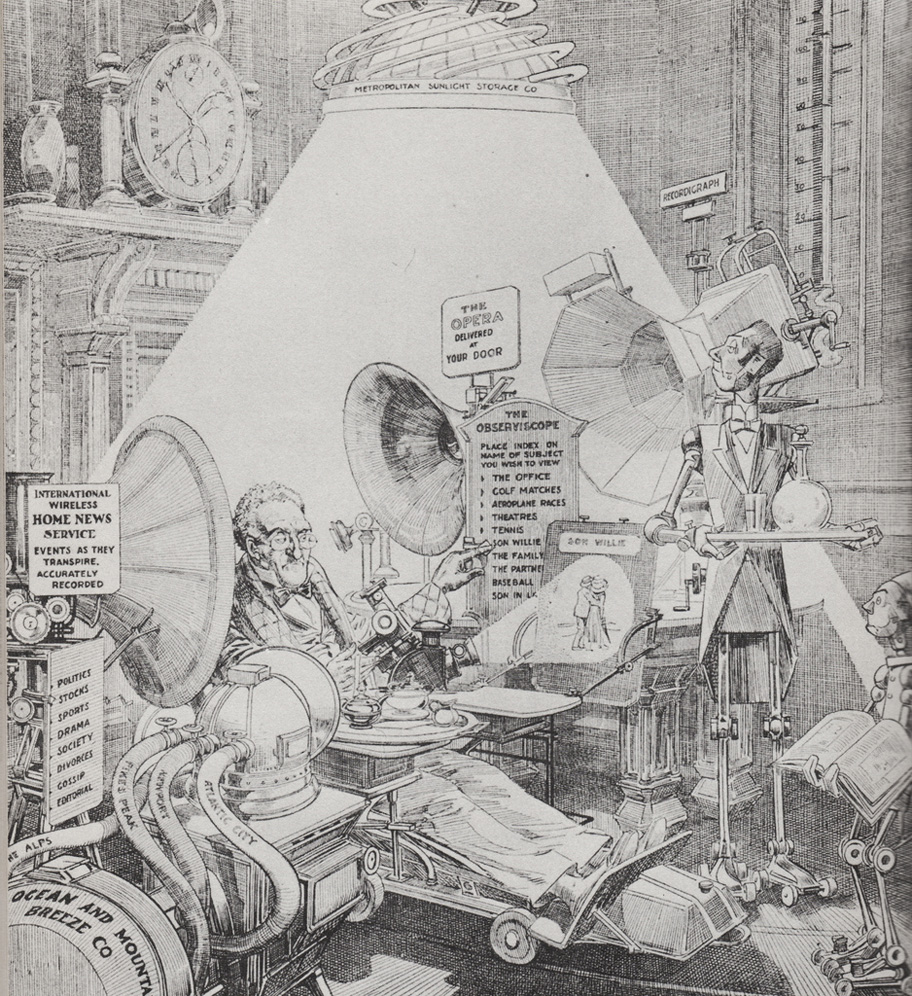
Before 1926
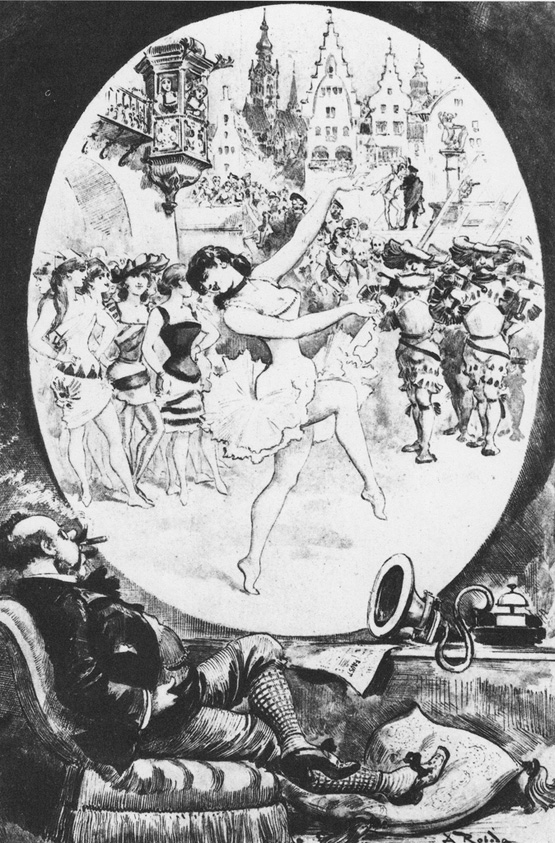
THE GENTLEMAN OF THE FUTURE ENJOYS A BURLESQUE SHOW FROM THE COMFORT OF HIS OWN HOME
In the late 19th and early 20th centuries no one knew for certain just what television technology would do — but they knew it was coming. The telephone and radio were in their infancy and it seemed like only a matter of time before visual communication across great distances would be accomplished. A small minority thought that the still-unrealized technology might be used for broadcasting, but many thought that it would be used for point-to-point audio and visual communication between just two people.
Albert Robida’s 1890 book Le Vingtieme Siecle imagined the gentleman of the future enjoying a burlesque show from the comfort of his own home.
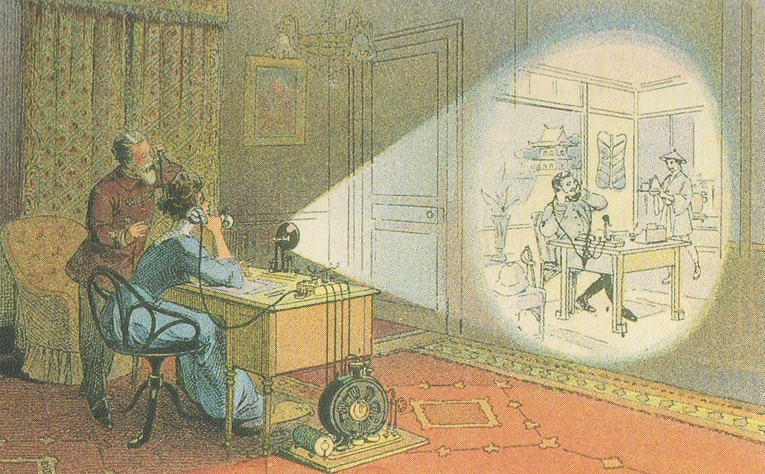
In 1912, the French chocolate company Lombart produced a series of promotional cards packaged with their sweets that looked at the futuristic world of the year 2012. One of the cards in the series showed parents in France speaking to their son in an unnamed Asian country through a mechanical telephone-television device.
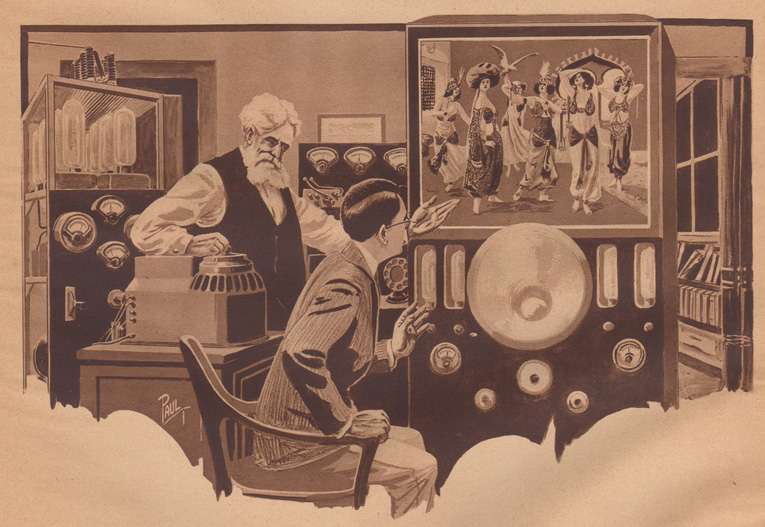
Hugo Gernsback is considered by many to be the father of modern science fiction, having started Amazing Stories (the world’s first magazine devoted entirely to science fiction) in 1926. Gernsback was also a pioneer in the world of radio, opening the world’s first radio store in 1909 in New York City. Gernsback published a number of different magazines in the 1920s and his fascination with radio spilled over into television as tinkerers and inventors were beginning to see some promise in the ability to wirelessly transmit moving pictures.
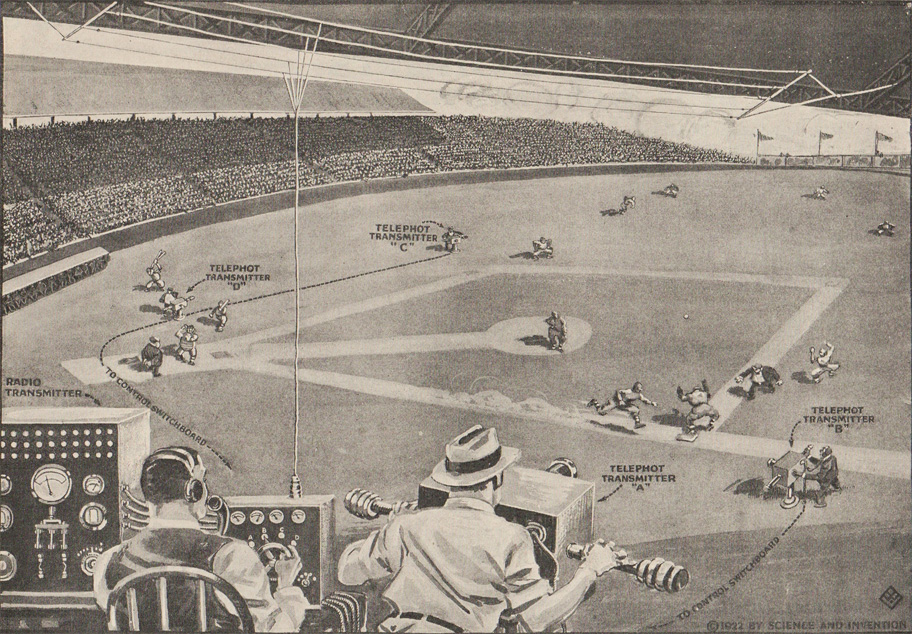
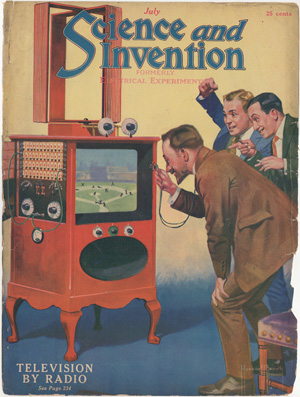
One of the magazines that Gernsback published was called Science and Invention, and on the cover of the July, 1922 issue he published what is probably the first illustration of a color TV receiving broadcast signals. Three men stand watching a baseball game — television tubes, wires, and knobs all exposed on the side of an orange TV set — a mechanical promise for the future of broadcasting. Inside this issue was an article explaining the futuristic principles of television and how it might be used as a broadcast medium in the future. It’s fascinating to see their vision of the television camera of the future, which they call a “telephot.”
In this illustration we behold how future audiences will see a baseball game thousands of miles away. Here we see a common radio transmitter to which are connected several telephot transmitters. The operators of the telephot transmitters A, B, C and D “shoot” the interesting parts of the game, but they do not do this simultaneously. They merely point the telephot transmitter into focus while the radio operator at his instrument switches from one to the other in order to get those close-ups which he wishes. The distant audience then will see whatever close-ups are selected by the radio operator. It naturally would not do to have just one telephot transmitter for the reason that at time, the operator would be either too far, or otherwise too close to the scene. By having a multiplicity of telephots, this is avoided.

“MOVIES BY RADIO! WHY NOT?”
Vladimir Zworykin, working for Westinghouse, applied for patents in the early and mid-1920s for things such as a two-way television system.
The February 8, 1925 issue of the San Antonio Light (San Antonio, TX) featured some predictions from Hugo Gernsback for the year 1975.
Movies by radio! Why not? You will be able to have a moving picture produced in some central plant and projected in your home, on your yacht, or on your camping trip, the picture being sent by radio, and received and projected upon your screen. All this is perfectly possible.
1926-1945
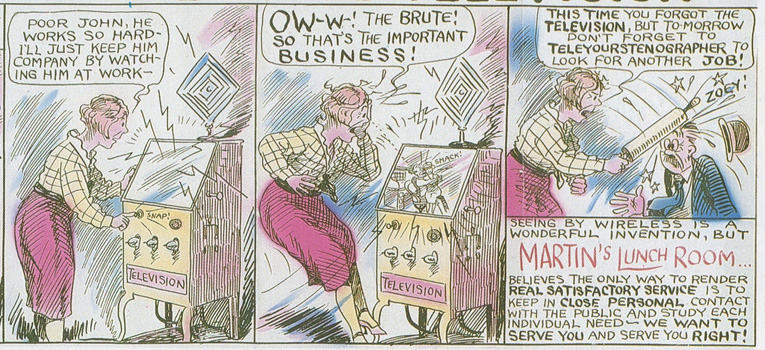
As early as 1884 Paul Nipkow applied for a patent in Germany for the first electromechanical method for sending images, but it was John Logie Baird — a Scottish inventor — who would develop mechanical television into a practical reality, providing the first public demonstration of his television in 1926 for the Royal Institution and a newspaper reporter in London.
“THE COMPLETE INFLUENCE OF TELEVISION UPON MODERN WARFARE BEWILDERS THE IMAGINATION.”
Baird was truly a visionary, and in 1927 made a rather prescient prediction about the effect television would have on warfare. From the May 15, 1927 Sioux City Journal (Sioux City, IA):
“[Television] will have at least as great an influence on future warfare. Someone has said that ‘If prospect of war can be made sufficiently horrible, nations will not fight,’ and television with the infra-red ray shows the hidden enemy to the distant general. Airplanes need no longer wireless scanty reports; equipped with an electric eye, they can reproduce the entire field of action, the very shell-bursts; moving troops, each in tiny detail, will be stripped of concealment. The complete influence of television upon modern warfare bewilders the imagination.”
Dr. Ernest F. W. Alexanderson, a consulting engineer at General Electric, was quite optimistic in 1927 about the future of television, predicting extraordinary advances, long before the most basic TV sets had really proved themselves: “We have already visualized that the radio broadcasting of motion pictures in full colors, sound and three-dimensional rendering may be possible.”
Nikola Tesla had his own futuristic vision for what television could accomplish. The January 26, 1927 issue of the Nevada State Journal explained Tesla’s hopes for the technology:
Application of radio principles will enable people by carrying a small instrument in their pockets to see distant events like the sorceress of the magic crystal fairy tales and legends, Nikola Tesla, electrical inventor, predicted today. Mr. Tesla, who on several occasion has tried to communicate with the planet Mars, made his predictions in an interview published in the current issue of Collier’s Weekly.
“We shall be able to witness the inauguration of a president, the playing of a world’s series baseball game, the havoc of an earthquake, or a battle just as though we were present,” Mr. Tesla said.
Gernsback predicted in the June, 1927 issue of Science and Invention:
It may take two years and even five years before every telephone and every radio set is finally equipped with its television attachment, but you may rest assured that this generation will soon personally witness the appearance of this stage of the art.
“SCIENCE HAS THE HABIT OF DOING THE UNFORSEEN, AND OFTEN THROWS OUR BEST AND MOST LOGICAL PREDICTIONS ON THE SCRAP HEAP.”
Interestingly, Gernsback’s 1927 article wasn’t so much concerned with the as yet imperfect and impractical medium, but instead with the future of television — a medium that hadn’t yet been clearly defined.
It is now possible to hear and see a person over a wire line, or over the radio. We have, therefore, made it possible to transport two senses, so to speak, to a distance, the two sense being sight and hearing.
In these days of wonder and achievement, we should ask ourselves the question, “What other of our senses is it possible to transport to a distance, and, from our present-day knowledge of science, is it possible to transport any of them at all?”
But Gernsback acknowledged that their thinking about television was incredibly limited. Just as radio had been envisioned as simply a point-to-point contact between people, but evolved with the advent of broadcasting, so too might television learn about how to reach the masses. A revolutionary idea for the time, but one that we take for granted today.
There was a time when we were talking first about radio telephony, when it was conceded by practically all of us who had a hand in the shaping of its destinies, that the logical thing would be talking by radio to our friends. Thus in the first book ever written on the subject “The Wireless Telephone,” published by me in 1908, before there was a Radiotelephone, I could see only one use for the coming invention and that was a parallel to the wire telephone. I did not dream of broadcasting, nor did any one else.
The same may be said of television. Right now we are glibly talking about television attachments on our telephones, and radio sets. We may be all wrong, and the new art of television may turn into entirely different directions, undreamt of today. Science has the habit of doing the unforseen, and often throws our best and most logical predictions on the scrap heap.


The December, 1928 issue of Science and Invention imagined 3D television technology being used in theaters, allowing people to watch using stereoscopes — technology that dates back to 1838.
A television drama of the future has been visualized here. The illustration below shows a dual image thrown on a screen, with the spectators viewing the performance through stereoscopes.
This system of stereoscopic 3D television was attempted on a smaller scale by Baird two years earlier, but it had proven impractical given the fact that it could only be watched by one person at a time.
“EVEN IF COLOR-PRINTING BE PERFECTED, WHAT CAN THE DAILY PRESS OFFER IN COMPETITION WITH SUCH A LURE, OR WHAT PALE PROMISE MAKE?”
Silas Bent, an author and journalist, saw the emerging technological improvements in television as a threat to print media, calling it in 1929 a “disturbing development”:
Fancy what this means. Sitting in your home you may witness distant events, observe the natural colors of the surroundings, and hear simultaneously the accompanying sounds. All the imperial pageantry and exotic color of a Sultan’s nuptials, dancing-girls and warriors, wild horsemen and chanting priests, might have their being in our very presence, so that we could all but touch them. Even if color-printing be perfected, what can the daily press offer in competition with such a lure, or what pale promise make?”
As Lawrence R. Samuel noted in his 2009 book Future: A Recent History, “Bent argued that, in order to survive, the newspaper business would have to split into two segments, one devoted to delivering serious information to intellectuals, the other to ‘the journalism of triviality and entertainment.'”
1929 also saw an illustration of the TV of the future in Judge magazine by illustrator Harry Grant Dart. A man bathing in the future is caught off guard by the woman who is calling him through the TV-telephone.
In the 1930s the Max Cigarette company issued a series of collectible cards with their smokes. Number 13 in the series of cards depicted the “television of the future.”
Linked with other modern marvels, television will open new worlds to everybody. Men in a bathysphere at sea-bed may transmit to the home set or to the cinema scenes taking place at the bottom of the ocean. The reporter of the future will be the television operator who broadcasts news to the world while it is taking place.
“MEN IN A BATHYSPHERE AT SEA-BED MAY TRANSMIT TO THE HOME SET OR TO THE CINEMA SCENES TAKING PLACE AT THE BOTTOM OF THE OCEAN.”
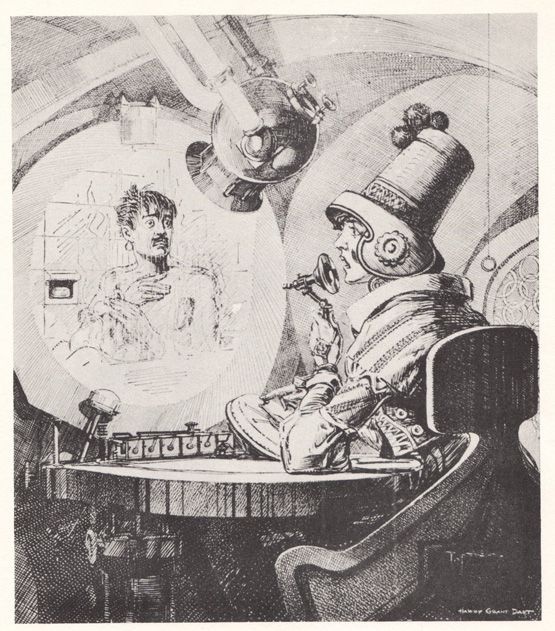
In 1935 there were twenty-eight TV broadcasting stations licensed by the FCC. Of these stations were roughly six actively broadcasting images. The May, 1935 issue of Short Wave Craft magazine asked “How Soon Shall We Have Television?” The article explored the various reasons why television development was lagging. On the one hand, the FCC wouldn’t issue licenses to TV broadcasting companies who wished to sell ads ostensibly because the picture quality was so poor as to be considered fraud. On the other hand, there needed to be investment in the endeavor if TV images were to improve. And if the US government wasn’t going to invest money into the development of a public broadcasting station, as was happening in England, then American broadcast TV had a very tenuous future.
Interestingly, John Logie Baird believed that the use of television technology in movie theaters would be of even more importance than use in the home, again raising different possibilities for this futuristic technology in the mind of the tech-nerd public. The November, 1937 Short Wave and Television magazine:
The future of motion-picture television is none the less of paramount importance, and may prove of even greater importance than television for the home. The future cinema will be a Telecinema, the present screen being replaced by a television screen; films, plays and topical events being broadcast direct to the various cinemas and theatres from central studios. The movie theatre proprietor will have the option of different programs from different centers.
Later, with a rather prescient prediction of popular visual culture, Baird imagines that sound will simply complement the images of the television:
The radio set of the future will be a Televisor, every receiver having its television screen. It is customary to think of television as an adjunct to sound broadcasting, but I think that finally sound will be regarded rather as the complement to the picture, just as it is in the motion picture. We have come to associate sound with broadcasting, because unlike the cinematograph, (motion picture projector) sound came before vision. None the less, vision is, in my opinion, the more important. We may recall how for many years the silent movie entertained millions.
Though the first public demonstration of television happened over a decade earlier, the 1939 New York World’s Fair is considered by most to be television’s coming out party. David Sarnoff of RCA proudly showed off the technology at the Fair, using electronic technology which had surpassed Baird’s mechanical TV technology in clarity and practicality.
But even then it hadn’t yet been determined whether it would be a two-way transceiver or a broadcast medium. The 1939 World’s Fair in New York far outshined its sister Fair in San Francisco that year. The San Francisco fair didn’t feature the same kind of futuristic exhibits like GM’s Futurama exhibit. However, that didn’t stop it from looking at the “telephone-television” of tomorrow. The July 24, 1940 Ukiah Republican Press in Ukiah, CA featured a photograph of a man talking to a woman through a telephone-television, as it was promised people would surely do in the future.
Television looked like it was going to be a reality very soon, even if people were still a little fuzzy on the details. But then World War II got in the way. Naturally, focus on television was averted to the war effort and everyone would simply have to wait.
“HELICOPTER TRAVEL! A NEW STREAMLINED HOME! AND TELEVISION!”
The theme of advertising any consumer product during the second World War seemed to be patience. Companies were constantly telling people that, ‘just you wait, once the war is over all of the wondrous advances of the future will arrive in short order.’ It was also popular to simply position your product next to those promises of the future, and the Stroehmann Brothers Company did that in an advertisement from 1944. Helicopter travel! A new streamlined home! And television!
The September 26, 1944 Altoona Mirror (Altoona, PA):
Tomorrow… watch these dreams come TRUE!
But don’t dream about the Bread of Tomorrow… IT’S HERE TODAY!
1945-1970
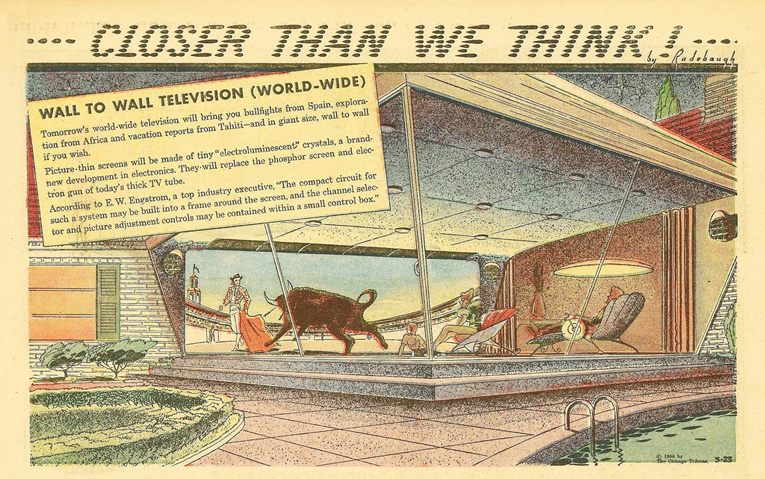
After World War II, television could finally pick up where it had left off — it had lost a lot of steam when the war effort shifted the world’s focus. Television would finally be realized as a broadcast medium, proving unmarketable, economically infeasible, and technically impractical as a transceiver device.
By the 1950s television was a standard appliance in many American homes and was seen as a growing threat to the movie industry. After all, what sick freak would want to go out if they could be entertained from the comfort of their own homes? This sparked a sort of arms race, as movies tried gimmicks like widescreen aspect ratios and 3D: “Hollywood’s answer to television.” Somewhat strangely — perhaps just to mess with the motion picture industry even further — the television industry insisted that it would soon be developing 3D entertainment for the home.
A 1953 Ohio newspaper proclaimed that, “Three dimensional television, described as television’s answer to Hollywood’s answer to television, makes its debut today at a press conference.”
Even after the public had grown weary of 3D cinema and the craze had largely fizzled out by the mid-1950s, television still had its eye on pushing the televised world into 3D. The Daily Telegram (Columbus, Nebraska) included an article on March 20, 1958 which described one such process:
Unlike the 3-D movie process that blossomed briefly, “depthagraph” does not utilize polarization to fuse a double image. Viewers wearing special glasses see the depth dimension. Those without glasses continue to receive a clear, two-dimensional picture. In TV patois, the system is completely compatible.
“Depthagraph” was developed by ex-actor William Free who predicts future TV shows will be strictly 3-D.
At first kiddie shows and commercials will take advantage of my process,” Free said. “Then, when there are 100 million pairs of glasses in the homes dramatic shows, Westerns and musicals will move into 3D.”
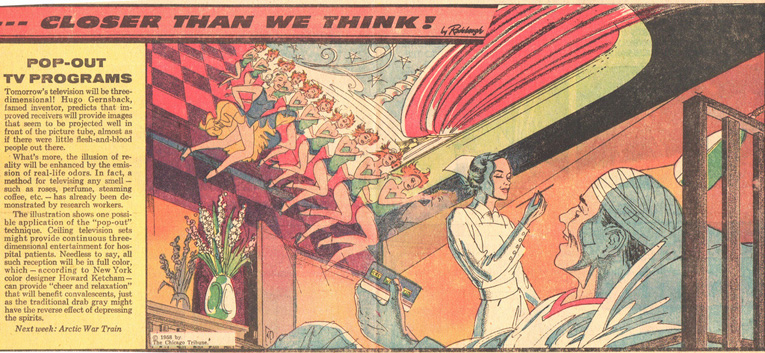
The Sunday comic strip “Closer Than We Think” appeared in newspapers throughout the US and Canada from 1958 until 1963. Illustrated by Arthur Radebaugh, the strip would pull snippets from future-oriented news stories of the day and imagine what those technologies might look like in practice. Today, we can look back at “Closer Than We Think” as pretty much the definitive techno-utopian aesthetic that we so often associate with mid-century futurism.
Naturally, the strip looked at the future of television a number of times — picturing wall-to-wall TV, 3D-TV, wristwatch TV, headphone TV (TV images projected inside your head), and even the spot-on predictions which we might find rather mundane in 2012 given how accurate they were. The February 1, 1959 edition of the strip looked at the electronic home library of the future:
Some unusual inventions for home entertainment and education will be yours in the future, such as the “television recorder” that RCA’s David Sarnoff described recently.
With this device, when a worthwhile program comes over the air while you are away from home, or even while you’re watching it, you’ll be able to preserve both the picture and sound on tape for replaying at any time. Westinghouse’s Gwilym Price expects such tapes to reproduce shows in three dimensions and color on screens as shallow as a picture.
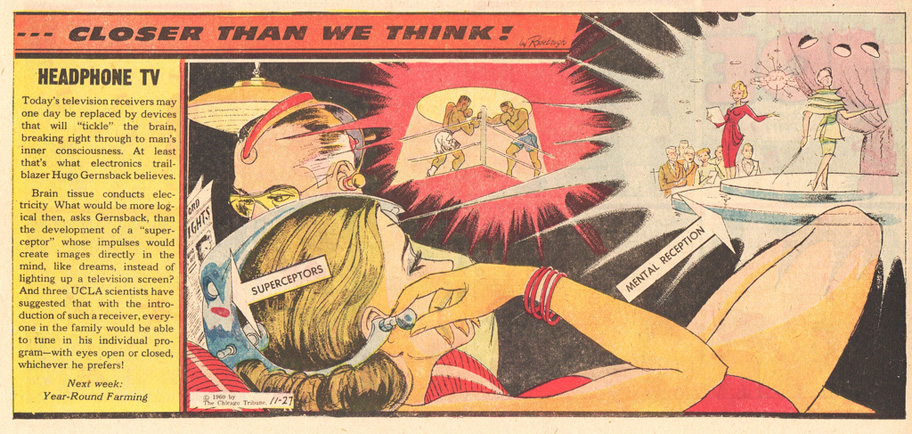
AT&T produced a film in 1962 titled Talking of Tomorrow. Directed by The Jetsonswriter Chuck Couch, the film looks at the nuclear family of tomorrow and how they might live, work, and play. The TV of the future is gigantic and allows Father and Junior to watch a (rather racially offensive) baseball game from around the world.
The mid-1960s was a tipping point for color television. In late 1961 the ABC show Walt Disney Presents moved to NBC and became Walt Disney’s Wonderful World of Color. At the beginning of 1965 there were an estimated 2,880,000 color TV sets in the US. This was an increase of 77 percent over the estimated 1,620,000 color sets at the beginning of 1964.
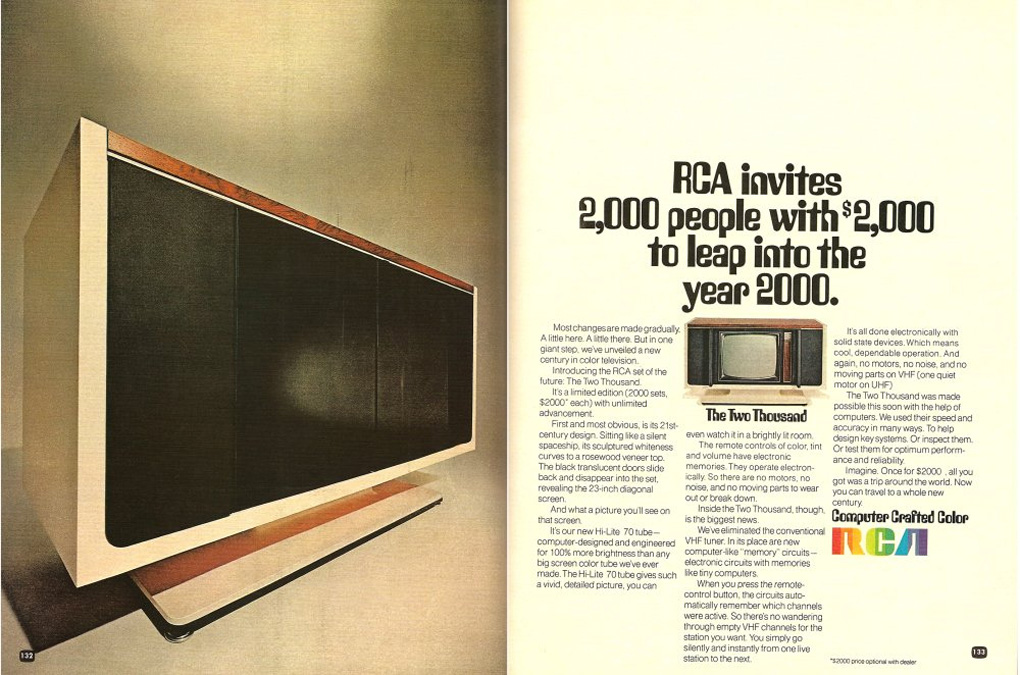
With color a mainstream reality, the future of television in the late-1960s began to focus on the staggering number of channels and technical improvements that would be at the average viewer’s disposal. In the November 30, 1968 Saturday Evening Post, the FCC’s Nicolas Jackson boldly declared in true techno-utopian fashion, “The future of television is no longer a question of what we can invent. It’s a question of what we want.”
“THE FUTURE OF TELEVISION IS NO LONGER A QUESTION OF WHAT WE CAN INVENT. IT’S A QUESTION OF WHAT WE WANT.”
In 1969 RCA marketed a limited-edition TV set that featured more brightness, more vivid color and a futuristic design. Called the Two Thousand, the TV actually had a similar design to the futuristic television illustrated in a 1964 children’s book called Rockets to Explore the Unknown by Don E. Rogers and illustrated by George Bakacs.
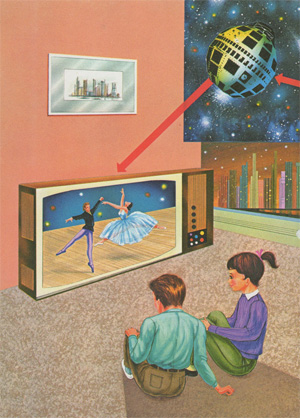
“AND WHAT A PICTURE YOU’LL SEE ON THAT SCREEN. “
From the December 18, 1969 Albuquerque Journal advertisement for RCA’s Two-Thousand TV set:
“In one giant step RCA harnessed the speed and accuracy of the computer to help unveil a new century in color television. It’s a limited edition (2,000 sets) with unlimited advancement.
First and most obvious, is its 21st century design, its sculptured whiteness curves to a rosewood veneer top. The black translucent doors slide back and disappear into the set, revealing the 23-inch diagonal screen.
And what a picture you’ll see on that screen.
It’s the new RCA Hi-Lite 70 tube-computer designed and engineered for 100% more brightness than any previous big screen RCA color tube. The Hi-Lite 70 tube gives such a vivid, detailed picture, you can even watch it in a brightly-lit room.
The remote controls of color, tint and volume are computer-designed too. They operate electronically so there are no motors, no noise, and no moving parts to wear out or break down.
Inside The Two Thousand, though, is the biggest news.
RCA eliminated the conventional VHF tuner. In its place are new computer-like “memory” circuits — electronic circuits with memories like tiny computers.
When you press the remote control button, the circuits automatically remember which channels you have programmed. So there’s no wandering through empty channels for the station you want. You simply go silently and instantly from one live station to the next.
Press the UHF lever and the signal seeking circuitry takes over. A silent motor sweeps up and down the UHF band, seeking an active channel. When it finds one it stops. There’s never any need to fine-tune the pictures. It’s done for you electronically.
The Two Thousand represents the pinnacle of achievement in Color TV engineering and performance. Open its doors and embark on a totally new viewing adventure.”
1970-2000
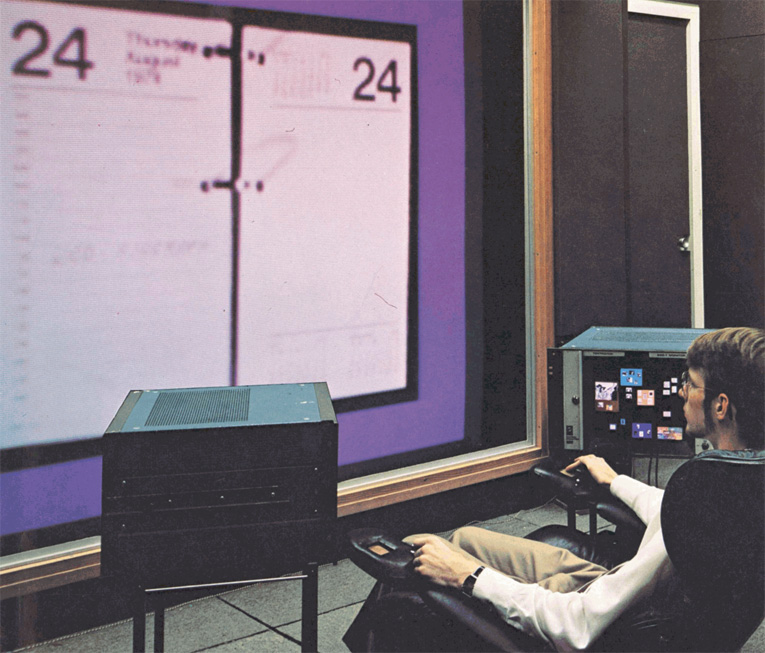
The tough economy of the 1970s painted many aspects of futurism in a decidedly more pessimistic light. Even when it came to television, there was no certainty that the future would be better (or at least more technologically wonderful). From the February 3, 1974 Oakland Tribune:
All those dreams of endless fun and self-improvement through the magic of super-television depended in part of the reigning ideology of the time which was: everything is always going to keep getting bigger and better.
Suddenly the doctrine of eternal abundance as a basic American right is seen as not so certain any more. We are running out of things. And the inevitability of progress can’t be taken quite so readily for granted.
It now seems possible that we won’t keep getting richer. The energy to run those room-size television screens and 3-D telecasts may have to be used for something more mundane…. like heating the joint or getting the old man to work and back.
The supersize television screens postulated a complete changeover in television technology; in other words, the scrapping of every piece of television equipment now in use — every home set, every camera and videotape machine. For, to increase the size of the screen considerably, we would have to increase the numbers of lines of transmission. That means new machines.
But by the 1970s it wasn’t all doom and gloom. Some saw the futuristic integration of television and computers. The 1979 book The Computer Age: A Twenty Year View looked at the home of the future and predicted pressure-sensitive controls that allowed one to interact with the TV.

Futurism is, more often than not, a reflection of the hopes and fears of the time in which it is created. The kinds of programming that Arthur C. Clarke imagined in his 1986 book, July 20, 2019 depict the hot button issues of the time: Latino immigration into the US, the complete collapse of government programs, and the role of Baby Boomers in the future. Clarke’s fictional TV programs of the future are summarized below:
“Don’t Mess with Me.” Tonight marks ABC’s first attempt at a new English-language situation comedy in prime time since the network went to all-Spanish programming a few years ago. A summer replacement, the series brings back one-time child star Gary Coleman (has he ever been away?) who plays the father of two adopted children. Beats reruns, anyway. (7:30 P.M.)
“So Who Wants to Work?” Jerry Rubin is the resident con man in a San Francisco retirement home where, ever since the collapse of Social Security, the old folks must rely on their wits to stay afloat. Rubin is particularly effective as the elderly baby-boomer wunderkind. In this episode, he convinces an oil company to use his pals in a TV commercial.
“YOU’LL NOT GO TO A VIDEO STORE BUT INSTEAD ORDER A MOVIE ON DEMAND AND THEN PAY FOR IT.”
The June, 1987 issue of Omni magazine looked at the predictions of Siskel and Ebert for the future of film and the home video market. Roger Ebert pretty accurately envisions a world of high-definition sets and movies on demand:
We will have high-definition, wide-screen television sets and a push-button dialing system to order the movie you want at the time you want it. You’ll not go to a video store but instead order a movie on demand and then pay for it. Videocassette tapes as we know them now will be obsolete both for showing prerecorded movies and for recording movies. People will record films on 8mm and will play them back using laser-disk/CD technology.

The rise of the personal computer in the 1980s meant that people now saw the possibilities for connecting their TVs to something much more futuristic. Essentially, the transformation of the 1990s was to be one of turning the television into a computer. The TV of the future would even allow you to interact with holograms, acting out plays in an immersive world, like in this illustration from the 1981 children’s book Tomorrow’s Home by Neil Ardley.
Look at this play of the future — a performance of Shakespeare’s Julius Caesar by famous actors in your very own living room! Even more amazing, you play the title role yourself. The play has just reached the point where Caesar is killed.
All this could come about with developments in holographic video — a system that uses laser beams to produce images that have depth just as in real life. Once perfected, it will produce a show that takes place not on a screen but in real space — even around you. You could walk in and out of the action, and view it from any direction — the ultimate in realism. In this case, the computer that operates the system has been instructed to omit the role of Julius Caesar so as to allow you to take part. Although the images look so real, you could walk through them, so you suffer no harm from your killers’ knives.
An internal Ameritech promotional video from the 1980s looked at the telecommunications services of tomorrow, including the fiber-optic delivered TV of the future:
A powerful microprocessor transforms a simple television into a sophisticated computer. Advanced television is challenging the United States to redefine broadcast TV standards and may require fiber-optic transmission. Advanced television could open a new service opportunity for Ameritech.
In true back to the future form, the video also says that the new high-speed fiber optic network being developed for television would allow for the videophones of the future. Irwin Dorros, the executive vice president of Bellcore talks in the video about the promise of “picturephone” (a word you pretty much never see used to refer to videophone technology after the 1960s):
With high-definition television the whole concept of two-way video communication can be revitalized. This, of course, is speculation but the potential is there. Because high definition television on a two-way tailored connection basis reopens… potentially reopens the limitations of picturephone and possibly would then be something in the market we really want.
And so we come full circle. The ebb and flow of futurism is a curious one. Technology isn’t cyclical (as Dennis Duffy said of pagers on NBC’s 30 Rock) but it would seem our technological predictions of the future may very well be repeating themselves. Forever. And ever.
The rush to create television was started by a rumor.
Image sources:
Albert Robida’s Le Vingtieme Siecle, 1890; Life Magazine, 1911; The History of the Future by Canto and Faliu, 1912; Science and Invention magazine, July 1922; Science and Invention magazine, October 1922; Science and Invention, December 1928; Judge magazine illustration by Harry Grant Dart, 1929; Admiral radio ad, 1943; Closer Than We Think, illustrated by Arthur Radebaugh, March 23, 1958; Rockets to Explore the Unknown by Don E. Rogers, illustrated by George Bakacs, 1964; RCA ad for the Two Thousand, Window to the Future by Steve Kosareff, 1969; The Computer Age: A Twenty-Year View, 1979;Tomorrow’s Home by Neil Ardley, 1981
